Analys
A remarkable rebound after an early summer lull

![]() The commodity market has witnessed a remarkable rebound since June. The Handelsbanken commodity index, including futures from all sectors, gained 10 %, which is due to a combination of various risk premiums, a lower USD and further cutbacks in Chinese supply reform. All told, there is a fragile trend of rising prices.
The commodity market has witnessed a remarkable rebound since June. The Handelsbanken commodity index, including futures from all sectors, gained 10 %, which is due to a combination of various risk premiums, a lower USD and further cutbacks in Chinese supply reform. All told, there is a fragile trend of rising prices.
Oil stuck in loop
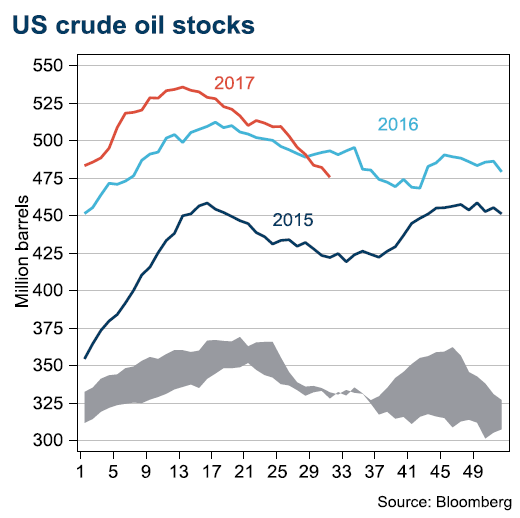
The price of crude oil has not been this uneventful in a long time. Over the past 12 months, the oil price has traded within a tight range, spanning just USD 13/bbl. However, in terms of short-term swings, the summer recovery has been relatively strong, up 15% since the low point in June.
The summer driving season in the US has been surprisingly strong given weaker consumption data during the spring. Consumables used to be a good leading indicator for fuel demand during summer. Yet, this year’s driving season has drawn on stocks, which are now lower than in 2016. However, that does not lead us to change our view of the oil price (USD 40/bbl at the end of 2017), as US oil production continues to increase and driving season demand is of course seasonal.
Venezuela has been the most relevant risk premium for commodity markets during summer. None of the remaining OPEC members are able to compensate for a full-scale breakdown of the Venezuelan oil tap.
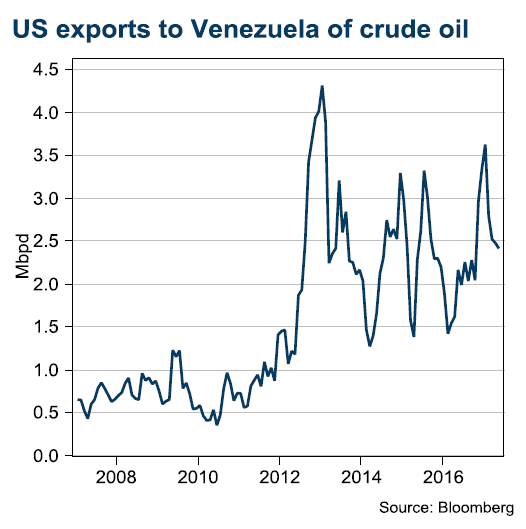
The heavy crude nature of Venezuela’s oil presents a suitable weak point for the Trump administration to exploit. Venezuela needs to import light crude oil to blend with its domestic production to create a saleable product. Hence, there are two main risks for oil prices in Venezuela, with the first being full-scale export sanctions from the US (in our view, imports elsewhere will come at a higher cost, but this problem could be solved). There is plenty of available light crude oil in Western Africa after the US lowered imports in the wake of the shale revolution. The second risk is a default in Venezuela. In such a scenario, we struggle to see oil workers continuing to work if salaries are frozen.
On the other hand, OPEC faces new challenges. Ecuador was the first member to leave the production accord officially and start to increase production and exports to meet its fiscal needs. Iraq followed shortly after, but now regrets this decision after an OPEC summit focusing on fading compliance within the group.
North Korea boosts bullion demand
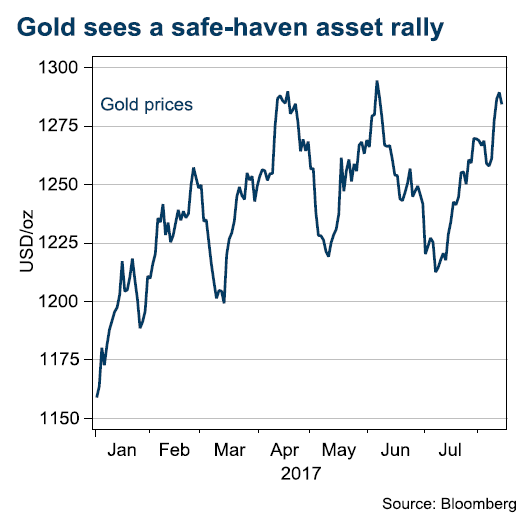 The escalating conflict around the Korean Peninsula affects commodities due to the lower USD and investors shunning risks. However, we believe this is a short-term story. Nevertheless, risk-averse strategies benefit gold. Prices approached USD 1,300 per ounce for the third time this year, fuelled by tougher rhetoric from Trump and North Korea’s improved ability to manufacture nuclear weapons.
The escalating conflict around the Korean Peninsula affects commodities due to the lower USD and investors shunning risks. However, we believe this is a short-term story. Nevertheless, risk-averse strategies benefit gold. Prices approached USD 1,300 per ounce for the third time this year, fuelled by tougher rhetoric from Trump and North Korea’s improved ability to manufacture nuclear weapons.
China forces cutbacks
Beijing has escalated the cutback campaign of unprofitable commodity production. Coal mining is now halfway to the 2020 target. Other bulk commodities are affected as well, particularly iron ore, which had the greatest price gain of all commodities during the summer, up 40% since June compared to coal’s 20%.
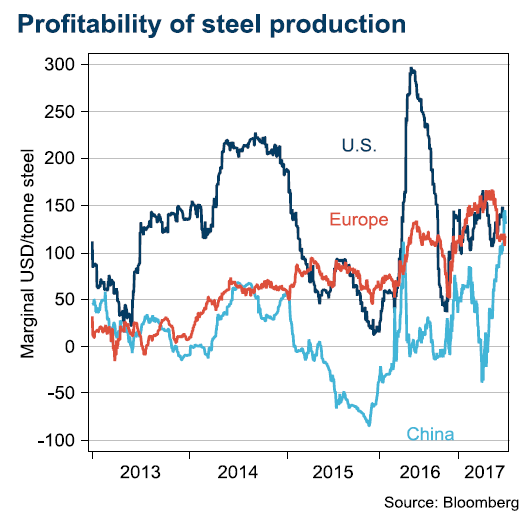 A cutback in domestic iron ore production spills over to freight rates. Capesize ships more than doubled during the past month. Buyers in China are looking to stockpile steelmaking raw materials before a crackdown on production creates a higher need for imports amid seasonally-slower domestic production during the winter months. Freight rates used to be volatile, but sometimes they offer clues about spot demand. They add a piece to our model-based calculation, showing Chinese steel mills have not been better off in terms of profits during the past five years.
A cutback in domestic iron ore production spills over to freight rates. Capesize ships more than doubled during the past month. Buyers in China are looking to stockpile steelmaking raw materials before a crackdown on production creates a higher need for imports amid seasonally-slower domestic production during the winter months. Freight rates used to be volatile, but sometimes they offer clues about spot demand. They add a piece to our model-based calculation, showing Chinese steel mills have not been better off in terms of profits during the past five years.
Base metals on solid ground
Of the summer gains, we believe base metals stand on the safest ground. However, aluminium has gained from announced cutbacks in China. Yet, in our view, that trend is vaguer than those for steel, iron ore and coal.
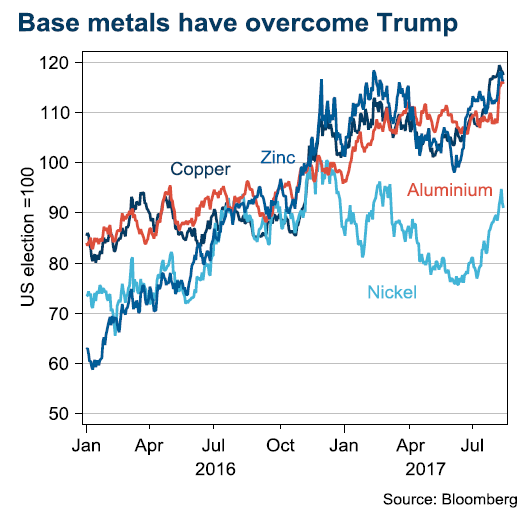 Others are trading high for good reasons, with zinc and copper at an impressive USD 2,900/t and USD 6,400/t respectively. However, this mirrors the current market balance, with mining in a sweet spot among the commodity producers. Nickel is still the laggard among base metals after the Philippines removed the mining closure campaign and miners triumphed against President Duarte’s environmental minister, Lopez. We believe this market will be flooded for a long time.
Others are trading high for good reasons, with zinc and copper at an impressive USD 2,900/t and USD 6,400/t respectively. However, this mirrors the current market balance, with mining in a sweet spot among the commodity producers. Nickel is still the laggard among base metals after the Philippines removed the mining closure campaign and miners triumphed against President Duarte’s environmental minister, Lopez. We believe this market will be flooded for a long time.
Research disclaimer
Risk warning
All investments involve risks and investors are encouraged to make their own decision as to the appropriateness of an investment in any securities referred to in this report, based on their specific investment objectives, financial status and risk tolerance. The historical return of a financial instrument is not a guarantee of future return. The value of financial instruments can rise or fall, and it is not certain that you will get back all the capital you have invested.
Research disclaimers
Handelsbanken Capital Markets, a division of Svenska Handelsbanken AB (publ) (collectively referred to herein as ‘SHB’), is responsible for the preparation of research reports. SHB is regulated in Sweden by the Swedish Financial Supervisory Authority, in Norway by the Financial Supervisory Authority of Norway, in Finland by the Financial Supervisory Authority and in Denmark by the Danish Financial Supervisory Authority. All research reports are prepared from trade and statistical services and other information that SHB considers to be reliable. SHB has not independently verified such information and does not represent that such information is true, accurate or complete. Accordingly, to the extent permitted by law, neither SHB, nor any of its directors, officers or employees, nor any other person, accept any liability whatsoever for any loss, however it arises, from any use of such research reports or its contents or otherwise arising in connection therewith.
In no event will SHB or any of its affiliates, their officers, directors or employees be liable to any person for any direct, indirect, special or consequential damages arising out of any use of the information contained in the research reports, including without limitation any lost profits even if SHB is expressly advised of the possibility or likelihood of such damages.
The views contained in SHB research reports are the opinions of employees of SHB and its affiliates and accurately reflect the personal views of the respective analysts at this date and are subject to change. There can be no assurance that future events will be consistent with any such opinions. Each analyst identified in this research report also certifies that the opinions expressed herein and attributed to such analyst accurately reflect his or her individual views about the companies or securities discussed in the research report.
Research reports are prepared by SHB for information purposes only. The information in the research reports does not constitute a personal recommendation or personalised investment advice and such reports or opinions should not be the basis for making investment or strategic decisions. This document does not constitute or form part of any offer for sale or subscription of or solicitation of any offer to buy or subscribe for any securities nor shall it or any part of it form the basis of or be relied on in connection with any contract or commitment whatsoever. Past performance may not be repeated and should not be seen as an indication of future performance. The value of investments and the income from them may go down as well as up and investors may forfeit all principal originally invested. Investors are not guaranteed to make profits on investments and may lose money. Exchange rates may cause the value of overseas investments and the income arising from them to rise or fall. This research product will be updated on a regular basis.
No part of SHB research reports may be reproduced or distributed to any other person without the prior written consent of SHB. The distribution of this document in certain jurisdictions may be restricted by law and persons into whose possession this document comes should inform themselves about, and observe, any such restrictions.
The report does not cover any legal or tax-related aspects pertaining to any of the issuer’s planned or existing debt issuances.
Analys
Tightening fundamentals – bullish inventories from DOE

The latest weekly report from the US DOE showed a substantial drawdown across key petroleum categories, adding more upside potential to the fundamental picture.

Commercial crude inventories (excl. SPR) fell by 5.8 million barrels, bringing total inventories down to 415.1 million barrels. Now sitting 11% below the five-year seasonal norm and placed in the lowest 2015-2022 range (see picture below).
Product inventories also tightened further last week. Gasoline inventories declined by 2.1 million barrels, with reductions seen in both finished gasoline and blending components. Current gasoline levels are about 3% below the five-year average for this time of year.
Among products, the most notable move came in diesel, where inventories dropped by almost 4.1 million barrels, deepening the deficit to around 20% below seasonal norms – continuing to underscore the persistent supply tightness in diesel markets.
The only area of inventory growth was in propane/propylene, which posted a significant 5.1-million-barrel build and now stands 9% above the five-year average.
Total commercial petroleum inventories (crude plus refined products) declined by 4.2 million barrels on the week, reinforcing the overall tightening of US crude and products.


Analys
Bombs to ”ceasefire” in hours – Brent below $70

A classic case of “buy the rumor, sell the news” played out in oil markets, as Brent crude has dropped sharply – down nearly USD 10 per barrel since yesterday evening – following Iran’s retaliatory strike on a U.S. air base in Qatar. The immediate reaction was: “That was it?” The strike followed a carefully calibrated, non-escalatory playbook, avoiding direct threats to energy infrastructure or disruption of shipping through the Strait of Hormuz – thus calming worst-case fears.

After Monday morning’s sharp spike to USD 81.4 per barrel, triggered by the U.S. bombing of Iranian nuclear facilities, oil prices drifted sideways in anticipation of a potential Iranian response. That response came with advance warning and caused limited physical damage. Early this morning, both the U.S. President and Iranian state media announced a ceasefire, effectively placing a lid on the immediate conflict risk – at least for now.
As a result, Brent crude has now fallen by a total of USD 12 from Monday’s peak, currently trading around USD 69 per barrel.
Looking beyond geopolitics, the market will now shift its focus to the upcoming OPEC+ meeting in early July. Saudi Arabia’s decision to increase output earlier this year – despite falling prices – has drawn renewed attention considering recent developments. Some suggest this was a response to U.S. pressure to offset potential Iranian supply losses.
However, consensus is that the move was driven more by internal OPEC+ dynamics. After years of curbing production to support prices, Riyadh had grown frustrated with quota-busting by several members (notably Kazakhstan). With Saudi Arabia cutting up to 2 million barrels per day – roughly 2% of global supply – returns were diminishing, and the risk of losing market share was rising. The production increase is widely seen as an effort to reassert leadership and restore discipline within the group.
That said, the FT recently stated that, the Saudis remain wary of past missteps. In 2018, Riyadh ramped up output at Trump’s request ahead of Iran sanctions, only to see prices collapse when the U.S. granted broad waivers – triggering oversupply. Officials have reportedly made it clear they don’t intend to repeat that mistake.
The recent visit by President Trump to Saudi Arabia, which included agreements on AI, defense, and nuclear cooperation, suggests a broader strategic alignment. This has fueled speculation about a quiet “pump-for-politics” deal behind recent production moves.
Looking ahead, oil prices have now retraced the entire rally sparked by the June 13 Israel–Iran escalation. This retreat provides more political and policy space for both the U.S. and Saudi Arabia. Specifically, it makes it easier for Riyadh to scale back its three recent production hikes of 411,000 barrels each, potentially returning to more moderate increases of 137,000 barrels for August and September.
In short: with no major loss of Iranian supply to the market, OPEC+ – led by Saudi Arabia – no longer needs to compensate for a disruption that hasn’t materialized, especially not to please the U.S. at the cost of its own market strategy. As the Saudis themselves have signaled, they are unlikely to repeat previous mistakes.
Conclusion: With Brent now in the high USD 60s, buying oil looks fundamentally justified. The geopolitical premium has deflated, but tensions between Israel and Iran remain unresolved – and the risk of missteps and renewed escalation still lingers. In fact, even this morning, reports have emerged of renewed missile fire despite the declared “truce.” The path forward may be calmer – but it is far from stable.
Analys
A muted price reaction. Market looks relaxed, but it is still on edge waiting for what Iran will do

Brent crossed the 80-line this morning but quickly fell back assigning limited probability for Iran choosing to close the Strait of Hormuz. Brent traded in a range of USD 70.56 – 79.04/b last week as the market fluctuated between ”Iran wants a deal” and ”US is about to attack Iran”. At the end of the week though, Donald Trump managed to convince markets (and probably also Iran) that he would make a decision within two weeks. I.e. no imminent attack. Previously when when he has talked about ”making a decision within two weeks” he has often ended up doing nothing in the end. The oil market relaxed as a result and the week ended at USD 77.01/b which is just USD 6/b above the year to date average of USD 71/b.

Brent jumped to USD 81.4/b this morning, the highest since mid-January, but then quickly fell back to a current price of USD 78.2/b which is only up 1.5% versus the close on Friday. As such the market is pricing a fairly low probability that Iran will actually close the Strait of Hormuz. Probably because it will hurt Iranian oil exports as well as the global oil market.
It was however all smoke and mirrors. Deception. The US attacked Iran on Saturday. The attack involved 125 warplanes, submarines and surface warships and 14 bunker buster bombs were dropped on Iranian nuclear sites including Fordow, Natanz and Isfahan. In response the Iranian Parliament voted in support of closing the Strait of Hormuz where some 17 mb of crude and products is transported to the global market every day plus significant volumes of LNG. This is however merely an advise to the Supreme leader Ayatollah Ali Khamenei and the Supreme National Security Council which sits with the final and actual decision.
No supply of oil is lost yet. It is about the risk of Iran closing the Strait of Hormuz or not. So far not a single drop of oil supply has been lost to the global market. The price at the moment is all about the assessed risk of loss of supply. Will Iran choose to choke of the Strait of Hormuz or not? That is the big question. It would be painful for US consumers, for Donald Trump’s voter base, for the global economy but also for Iran and its population which relies on oil exports and income from selling oil out of that Strait as well. As such it is not a no-brainer choice for Iran to close the Strait for oil exports. And looking at the il price this morning it is clear that the oil market doesn’t assign a very high probability of it happening. It is however probably well within the capability of Iran to close the Strait off with rockets, mines, air-drones and possibly sea-drones. Just look at how Ukraine has been able to control and damage the Russian Black Sea fleet.
What to do about the highly enriched uranium which has gone missing? While the US and Israel can celebrate their destruction of Iranian nuclear facilities they are also scratching their heads over what to do with the lost Iranian nuclear material. Iran had 408 kg of highly enriched uranium (IAEA). Almost weapons grade. Enough for some 10 nuclear warheads. It seems to have been transported out of Fordow before the attack this weekend.
The market is still on edge. USD 80-something/b seems sensible while we wait. The oil market reaction to this weekend’s events is very muted so far. The market is still on edge awaiting what Iran will do. Because Iran will do something. But what and when? An oil price of 80-something seems like a sensible level until something do happen.
-

 Nyheter4 veckor sedan
Nyheter4 veckor sedanStor uppsida i Lappland Guldprospekterings aktie enligt analys
-

 Nyheter4 veckor sedan
Nyheter4 veckor sedanSilverpriset släpar efter guldets utveckling, har mer uppsida
-

 Nyheter3 veckor sedan
Nyheter3 veckor sedanUppgången i oljepriset planade ut under helgen
-

 Nyheter3 veckor sedan
Nyheter3 veckor sedanLåga elpriser i sommar – men mellersta Sverige får en ökning
-

 Nyheter2 veckor sedan
Nyheter2 veckor sedanMahvie Minerals växlar spår – satsar fullt ut på guld
-

 Analys3 veckor sedan
Analys3 veckor sedanVery relaxed at USD 75/b. Risk barometer will likely fluctuate to higher levels with Brent into the 80ies or higher coming 2-3 weeks
-

 Nyheter2 veckor sedan
Nyheter2 veckor sedanOljan, guldet och marknadens oroande tystnad
-

 Nyheter2 veckor sedan
Nyheter2 veckor sedanJonas Lindvall är tillbaka med ett nytt oljebolag, Perthro, som ska börsnoteras









